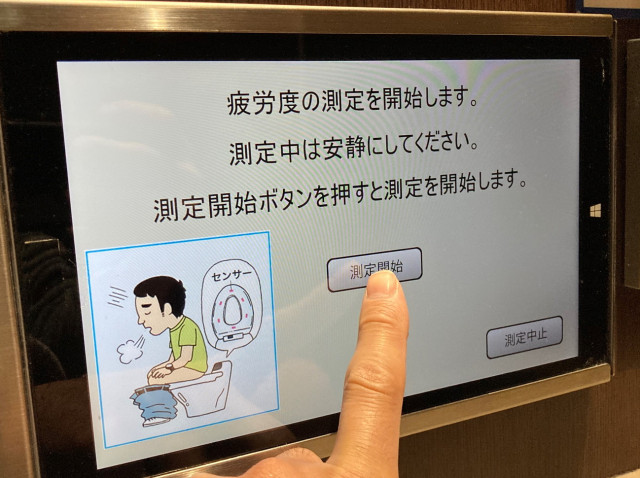
We test out the new system to see if it really can gauge tiredness while you have your pants down.
Health and safety experts are always warning us of the dangers of tiredness, particularly when it comes to driving long distances on the nation’s highways. And while car navigation systems have built-in announcements reminding drivers to take a break every two hours or so, it’s not always easy to judge how tired your body really is…until it’s too late.
Our reporter Masanuki Sunakoma is known for being a cautious driver who likes to take regular breaks at highway rest stops, particularly the bigger “Service Area” ones, which are abbreviated to “SA“. These stops have everything tired drivers and passengers need to re-energise, with loads of great food options, souvenir stands, and sometimes exciting extras like ferris wheels and onsen hot springs.
▼ One of the nation’s best Service Areas is Kanagawa Prefecture’s Ebina Service Area, located roughly 45 minutes from Tokyo by car.
To give you an idea of just how popular this highway rest stop is, one of the stores on the premises that sells melon breads holds the Guinness World Record for the most freshly baked sweet buns sold in 48 hours.
▼ This store won the record for selling 27,503 buns, totalling 6,329,830 yen (US$57.730).
Now, Ebina Service Area is making news again, this time for a very unusual toilet. Masanuki stopped by to try the new system out, and when he saw a green sign on one of the toilet stall doors that read “Fatigue Measurement“, he knew he’d come to the right place.
Stepping inside the stall, he took a seat and saw a digital display with buttons on the right-hand side for controlling the bidet and running water noises that mask the sounds of you doing your business. On the left-hand side of the panel were the words “Fatigue Measurement” in blue, with a variety of language options beneath it.
▼ Despite not feeling tired at all, Masanuki pressed “Japanese” to begin the measurement process.
One of the first concerns people may have about trying the new system is the fear that cameras may be involved in the measurement process. However, you can rest assured that no cameras are used–instead, there are vibration sensors built into the toilet seat that analyse “pulse fluctuations” which are able to calculate an individual’s fatigue levels.
▼ Before agreeing to use the system, this screen pops up to let you know that it will take roughly 60 seconds to measure your degree of fatigue.
▼ Then all you have to do is choose your age bracket…
▼ …And answer the question “Do you feel tired?” with either “Not tired“, “Somewhat Tired” or “Tired” (top to bottom)
Having not driven for very long from Tokyo, Masanuki felt as fresh as a daisy, so he selected the “Not Tired” response. While he initially thought that revealing his tiredness levels to the machine would skew the results, he later figured the data was most likely going to be used by East Nippon Expressway Company (NEXCO) to find out how many drivers can accurately judge their tiredness levels.
Masanuki then pressed the “start” button, and followed the instructions to relax while the measurement was being taken.
▼ The image on the left shows the location of the sensors around the toilet seat.
As the measurement began, Masanuki was surprised to see the panel come to life with a wealth of data. The information on the screen explained:
“In a fatigued state, the tension of the sympathetic nervous system increases and the activity of the parasympathetic nervous system decreases, so this toilet measures the fluctuation in beats and analyses the autonomic nervous system.”
▼ Masanuki had no idea what this all meant, so he waited patiently for the results to appear.
As he waited, the screen informed him that drivers should take a 10-20 minute break every two hours when driving, and suggested they use service areas or parking areas to take their breaks.
And then, after the 60 seconds was up, Masanuki received his results, which read: “You don’t feel tired. You’re fatigue measurement is ‘somewhat tired'”.
Okay, machine–way to troll the user for not knowing their tiredness levels! Masanuki felt as if the screen was mocking him for being so incompetent, but hey, who was he to question the results of science?
Masanuki says he can drive non-stop for about five hours without feeling tired if he really has to, so he took the results as a wake-up call to pay more attention to rest breaks, given that his true sense of fatigue may not be accurate.
▼ Either way, a stop at Ebina is a good excuse to enjoy a coffee and one of their famous melon breads.
As he enjoyed his snack, he mused on the cleverness of installing fatigue-measuring toilets at highway rest stops. Not only are they a great way to get people to stop at service areas like this one, and unload some of their money on snacks and souvenirs, they’re likely to reduce the number of accidents on the highways, which is a win-win for NEXCO and everyone using the roads.
Masanuki would love to see these fancy toilets become the norm at all rest stops around Japan, but for now, you’ll have to stop at Ebina to try them. Lovers of motorsports, however, may want to travel a little further down to Mie Prefecture, where you can park your rear on a toilet that looks–and sounds–like you’re on the track at the nearby Suzuka Racing Circuit.
Information
Ebina Service Area Outbound / 海老名サービスエリア(下り)
Address: Kanagawa-ken, Ebina-shi, Oyaminami 5-2-1
神奈川県海老名市大谷南5丁目2-1
Website
Images © SoraNews24
● Want to hear about SoraNews24’s latest articles as soon as they’re published? Follow us on Facebook and Twitter!
[ Read in Japanese ]



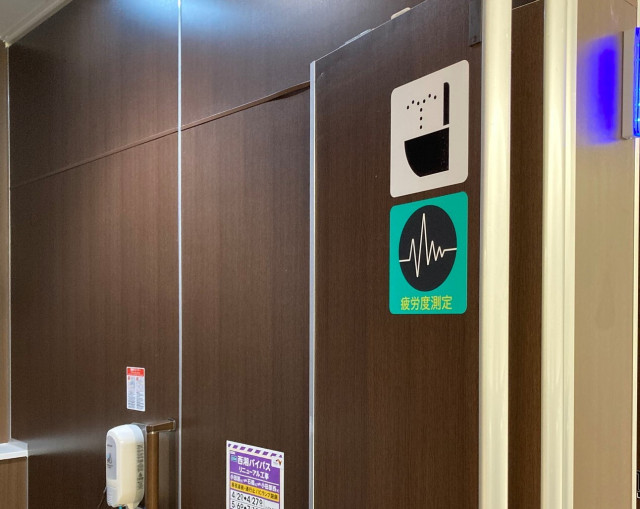

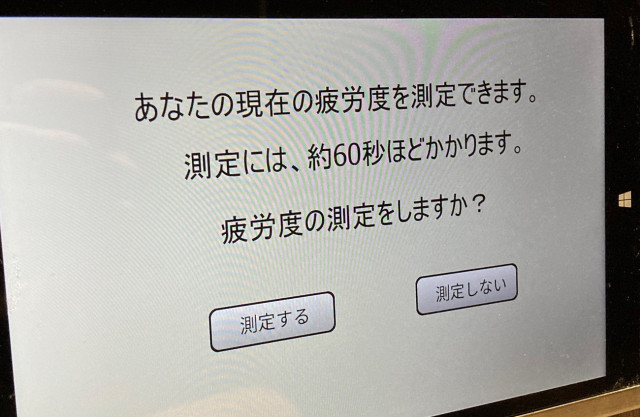
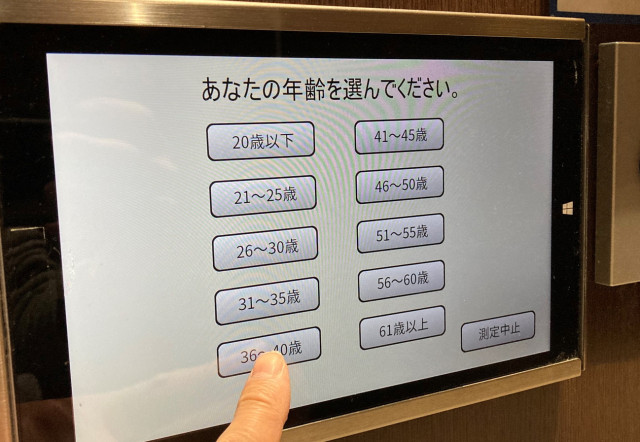
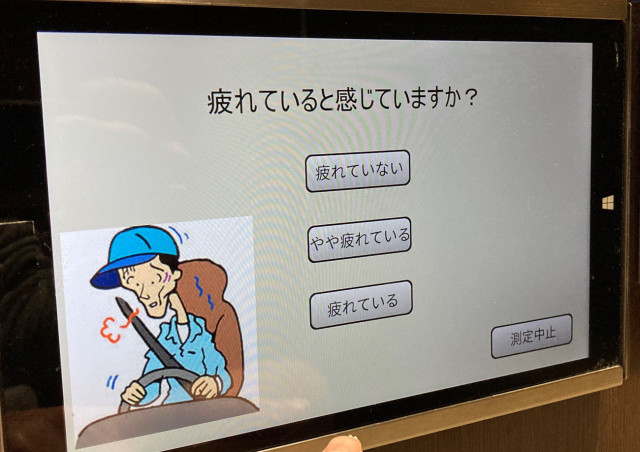
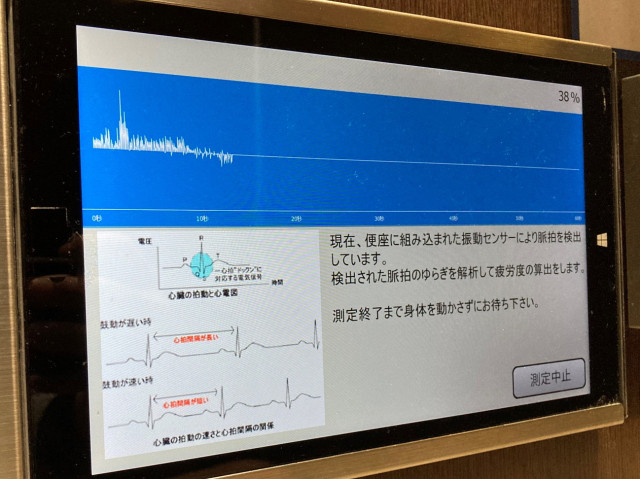
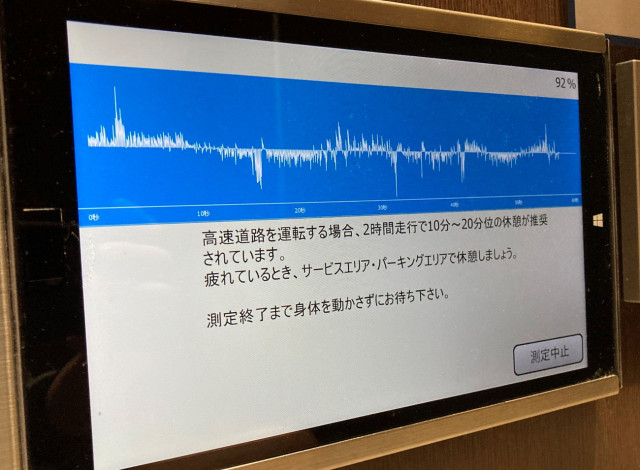
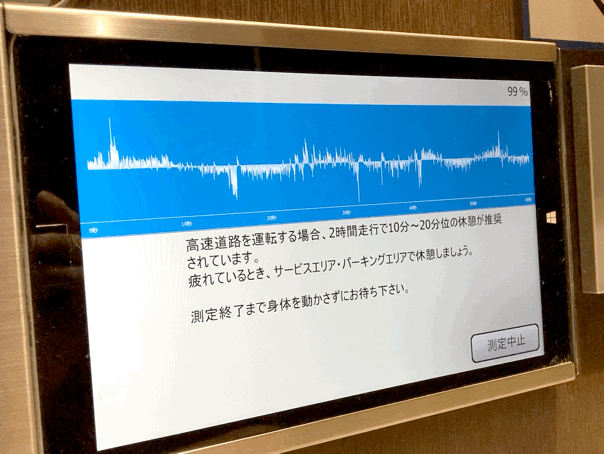
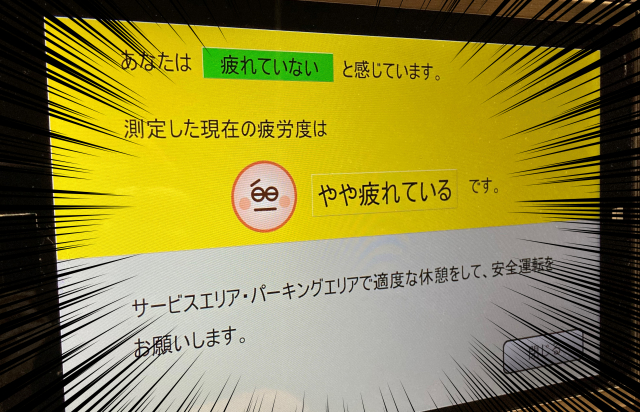

 Japanese toilets become even more high-tech with new floating panels
Japanese toilets become even more high-tech with new floating panels The reasons why Japanese highway rest stops have angled parking
The reasons why Japanese highway rest stops have angled parking Japanese toilet thrills motorsports fans at Suzuka F1 racing circuit highway service area【Video】
Japanese toilet thrills motorsports fans at Suzuka F1 racing circuit highway service area【Video】 What happened when Conan O’Brien visited the Toto Japanese toilet showroom in Tokyo 【Video】
What happened when Conan O’Brien visited the Toto Japanese toilet showroom in Tokyo 【Video】 Japanese public toilet in Tokyo has windows that change colour when you use it
Japanese public toilet in Tokyo has windows that change colour when you use it Pizza Hut Japan’s hot lucky bags are perfect for a New Year’s pizza party
Pizza Hut Japan’s hot lucky bags are perfect for a New Year’s pizza party We found possibly the quietest Japanese-style hotel in Tokyo’s bustling Shinjuku district
We found possibly the quietest Japanese-style hotel in Tokyo’s bustling Shinjuku district 7 great places to see Mt. Fuji from without having to climb it
7 great places to see Mt. Fuji from without having to climb it The top 70 words that keep showing up in Japanese light novel titles (and yes, isekai is one of them)
The top 70 words that keep showing up in Japanese light novel titles (and yes, isekai is one of them) Japanese thug wear from Birth Japan perfect for those breaking bad next year
Japanese thug wear from Birth Japan perfect for those breaking bad next year All-you-can-eat yakiniku in Shinjuku for less than 10 bucks!
All-you-can-eat yakiniku in Shinjuku for less than 10 bucks! 7-Eleven Japan starts new temporary luggage storage service in over 300 branches
7-Eleven Japan starts new temporary luggage storage service in over 300 branches 7-Eleven Japan’s ramen-cooking robot whipped us up a bowl of noodles【Taste test】
7-Eleven Japan’s ramen-cooking robot whipped us up a bowl of noodles【Taste test】 Prominent boob-centric manga artist shocks fans by revealing she’s a beautiful buxom woman
Prominent boob-centric manga artist shocks fans by revealing she’s a beautiful buxom woman Eight Ways You Really, Really Shouldn’t Use a Japanese Toilet
Eight Ways You Really, Really Shouldn’t Use a Japanese Toilet Starbucks Japan ready to get Year of the Horse started with adorable drinkware and plushies【Pics】
Starbucks Japan ready to get Year of the Horse started with adorable drinkware and plushies【Pics】 Cyberpunk anime meets traditional culture in Ghost in the Shell gold leaf Japanese changing screens
Cyberpunk anime meets traditional culture in Ghost in the Shell gold leaf Japanese changing screens Hello Kitty Choco Egg figures are an adorable trip through three periods of Japanese pop culture【Pics】
Hello Kitty Choco Egg figures are an adorable trip through three periods of Japanese pop culture【Pics】 Japan’s otoshidama tradition of giving kids money at New Year’s gets a social welfare upgrade
Japan’s otoshidama tradition of giving kids money at New Year’s gets a social welfare upgrade Lacquerware supplier to emperor of Japan and Pokémon team up for new tableware
Lacquerware supplier to emperor of Japan and Pokémon team up for new tableware Sumo Sanrio! Hello Kitty and pals team up with Japan Sumo Association for new merch【Pics】
Sumo Sanrio! Hello Kitty and pals team up with Japan Sumo Association for new merch【Pics】 Can a dirty butthole make you filthy rich in Japan? We’re starting a New Year’s lottery experiment
Can a dirty butthole make you filthy rich in Japan? We’re starting a New Year’s lottery experiment Disillusionment at Tsukiji’s tourist-target prices led us to a great ramen restaurant in Tokyo
Disillusionment at Tsukiji’s tourist-target prices led us to a great ramen restaurant in Tokyo Starbucks teams up with 166-year-old Kyoto doll maker for Year of the Horse decorations【Photos】
Starbucks teams up with 166-year-old Kyoto doll maker for Year of the Horse decorations【Photos】 Tokyo considering law requiring more trash cans following litter increase in heavily touristed area
Tokyo considering law requiring more trash cans following litter increase in heavily touristed area Tokyo’s Tsukiji sushi neighborhood asks tour groups to stay away for the rest of the month
Tokyo’s Tsukiji sushi neighborhood asks tour groups to stay away for the rest of the month Nintendo’s Kirby now delivering orders at Kura Sushi restaurants, but not in Japan
Nintendo’s Kirby now delivering orders at Kura Sushi restaurants, but not in Japan Tokyo event lets you travel back in time, for free, to celebrate 100 years since Showa era start
Tokyo event lets you travel back in time, for free, to celebrate 100 years since Showa era start Sanrio theme park in Japan announces plans to expand into a Sanrio resort
Sanrio theme park in Japan announces plans to expand into a Sanrio resort Japan may add Japanese language proficiency, lifestyle classes to permanent foreign resident requirements
Japan may add Japanese language proficiency, lifestyle classes to permanent foreign resident requirements Survey asks foreign tourists what bothered them in Japan, more than half gave same answer
Survey asks foreign tourists what bothered them in Japan, more than half gave same answer Japan’s human washing machines will go on sale to general public, demos to be held in Tokyo
Japan’s human washing machines will go on sale to general public, demos to be held in Tokyo Japan’s deadliest food claims more victims, but why do people keep eating it for New Year’s?
Japan’s deadliest food claims more victims, but why do people keep eating it for New Year’s? We deeply regret going into this tunnel on our walk in the mountains of Japan
We deeply regret going into this tunnel on our walk in the mountains of Japan Studio Ghibli releases Kodama forest spirits from Princess Mononoke to light up your home
Studio Ghibli releases Kodama forest spirits from Princess Mononoke to light up your home Major Japanese hotel chain says reservations via overseas booking sites may not be valid
Major Japanese hotel chain says reservations via overseas booking sites may not be valid Put sesame oil in your coffee? Japanese maker says it’s the best way to start your day【Taste test】
Put sesame oil in your coffee? Japanese maker says it’s the best way to start your day【Taste test】 No more using real katana for tourism activities, Japan’s National Police Agency says
No more using real katana for tourism activities, Japan’s National Police Agency says Starbucks Japan reveals new sakura drinkware collection, inspired by evening cherry blossoms
Starbucks Japan reveals new sakura drinkware collection, inspired by evening cherry blossoms Updated cherry blossom forecast shows extra-long sakura season for Japan this year
Updated cherry blossom forecast shows extra-long sakura season for Japan this year We travel to Fuji to see how they make Japanese toilet paper
We travel to Fuji to see how they make Japanese toilet paper Japanese toilet paper collection opens our minds as we open our butts
Japanese toilet paper collection opens our minds as we open our butts Vending machine serves coffee by a Japanese actor with Surfin’ USA music and video while you wait
Vending machine serves coffee by a Japanese actor with Surfin’ USA music and video while you wait
Leave a Reply